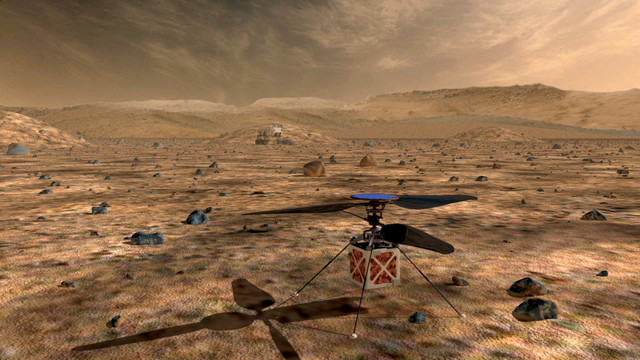
by Timothy Oleson Monday, April 20, 2015

Small solar-powered helicopters, like that depicted in this artist's drawing, might accompany future rover missions on Mars, flying ahead to scout terrain and help operators on Earth plot better routes. Credit: NASA/JPL-Caltech.
With two rovers patrolling the surface of Mars, five spacecraft in orbit above it, and scientists back here on Earth studying the Red Planet from afar, new findings are announced almost weekly. Here are a few of the latest updates.
Despite several years of study, the explanation for enormous plumes that formed in Mars’ atmosphere in 2012 continues to prove elusive, according to a study in Nature. First seen by amateur astronomers, imagery of the plumes was then pored over by researchers to characterize them in detail. After arising quickly, the shape-shifting plumes each lasted about 10 days, extending 500 to 1,000 kilometers across. The features reached an astounding 200 to 250 kilometers above the planet’s surface, roughly twice as high as the maximum altitudes of previously observed dust plumes, water and carbon dioxide clouds, and aurorae, reported Agustin Sánchez-Lavega of the University of the Basque Country in Bilbao, Spain, and colleagues. The leading hypotheses still invoke ice clouds or auroral emissions, the researchers wrote. “Both explanations,” they added, “defy our current understanding of Mars’ upper atmosphere.”
Future Mars rovers might have airborne companions scouting terrain and potential study sites for them on their treks across the Red Planet. Engineers at NASA’s Jet Propulsion Laboratory in Pasadena, Calif., are developing a lightweight, camera-equipped helicopter to give rover drivers a broader field of vision and a different perspective on the landscape. With a body about the size of a cube-shaped tissue box and dual 1.1-meter rotors, the current solar-powered design could only fly for a few minutes each day through Mars’ thin atmosphere, limiting it to about half a kilometer at a time. But even this capability would allow operators to plot more efficient routes and decrease travel time across the rocky surface, according to a NASA press release. To watch a brief video about the helicopter’s early development, go to: http://www.jpl.nasa.gov/video/details.php?id=1355.
Huge landslides that transport rock and debris 50 kilometers or more appear to have been common on Mars for billions of years, particularly in Valles Marineris, the planet’s vast equatorial canyon system. Explanations for these “long-runout landslides,” which are rare on Earth, have suggested that water, ice, evaporite minerals or trapped air may lubricate a weak subsurface layer, which eventually fails and facilitates a slide — but the phenomenon has remained a mystery. Now, based on spectral data and imagery from the Mars Reconnaissance Orbiter and Mars Odyssey missions, researchers have suggested another possible contributor to the massive mass failures: clay. Jessica Watkins of the University of California at Los Angeles and colleagues found evidence of hydrated silicates, likely clay minerals such as smectite, in debris near the toe of a well-exposed 75-kilometer-long slide. This clay, thought to have formed through water-rock reactions in Mars’ earlier, wetter history, could also have lubricated landslides, allowing them to travel farther than they would have otherwise, the researchers noted in Geology. Unlike other proposed lubricants, the abundance of clays in the subsurface would not have changed much with shifting climatic conditions after they formed. This “climate-independent” explanation is thus more consistent with the observation of similar long-runout landslides occurring often in Valles Marineris between 3.5 billion and 50 million years ago, during which time the climate changed substantially, they suggested. It also highlights how early water on Mars has exerted “a long-lasting influence on” shaping the planet’s surface.
© 2008-2021. All rights reserved. Any copying, redistribution or retransmission of any of the contents of this service without the expressed written permission of the American Geosciences Institute is expressly prohibited. Click here for all copyright requests.